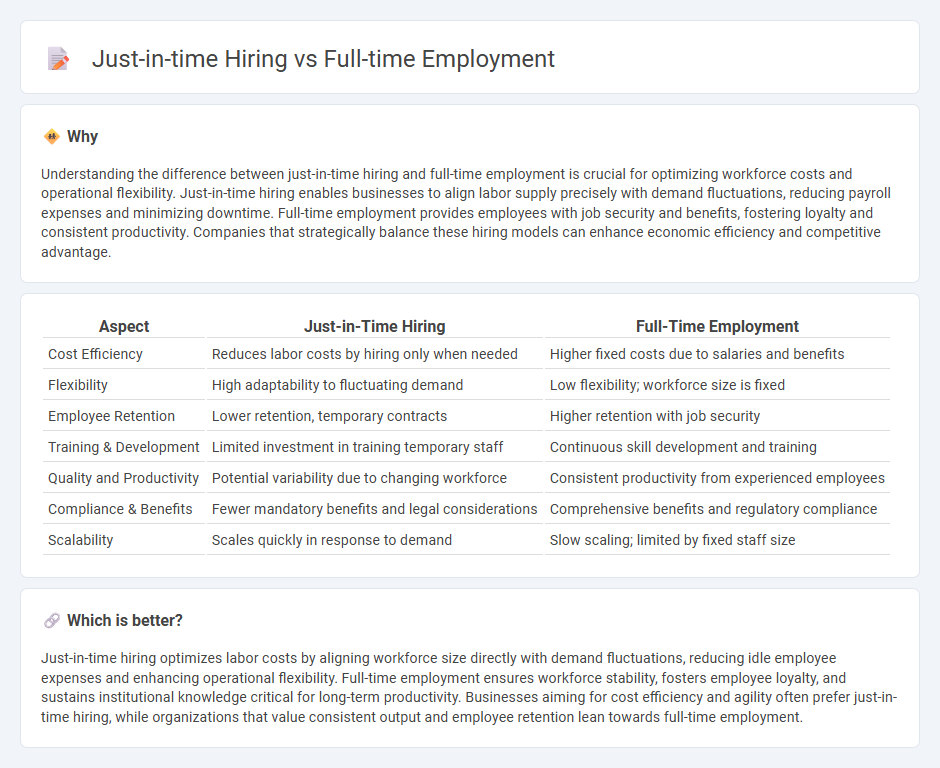
Just-in-time hiring strategically aligns workforce size with fluctuating demand, minimizing labor costs and increasing operational agility compared to traditional full-time employment models that incur fixed expenses regardless of workload. This approach allows businesses to swiftly adjust staffing levels, optimize resource allocation, and respond to market volatility without long-term commitments. Explore the advantages and challenges of just-in-time hiring versus full-time employment to understand which strategy best fits your organizational goals.
Why it is important
Understanding the difference between just-in-time hiring and full-time employment is crucial for optimizing workforce costs and operational flexibility. Just-in-time hiring enables businesses to align labor supply precisely with demand fluctuations, reducing payroll expenses and minimizing downtime. Full-time employment provides employees with job security and benefits, fostering loyalty and consistent productivity. Companies that strategically balance these hiring models can enhance economic efficiency and competitive advantage.
Comparison Table
| Aspect | Just-in-Time Hiring | Full-Time Employment |
|---|---|---|
| Cost Efficiency | Reduces labor costs by hiring only when needed | Higher fixed costs due to salaries and benefits |
| Flexibility | High adaptability to fluctuating demand | Low flexibility; workforce size is fixed |
| Employee Retention | Lower retention, temporary contracts | Higher retention with job security |
| Training & Development | Limited investment in training temporary staff | Continuous skill development and training |
| Quality and Productivity | Potential variability due to changing workforce | Consistent productivity from experienced employees |
| Compliance & Benefits | Fewer mandatory benefits and legal considerations | Comprehensive benefits and regulatory compliance |
| Scalability | Scales quickly in response to demand | Slow scaling; limited by fixed staff size |
Which is better?
Just-in-time hiring optimizes labor costs by aligning workforce size directly with demand fluctuations, reducing idle employee expenses and enhancing operational flexibility. Full-time employment ensures workforce stability, fosters employee loyalty, and sustains institutional knowledge critical for long-term productivity. Businesses aiming for cost efficiency and agility often prefer just-in-time hiring, while organizations that value consistent output and employee retention lean towards full-time employment.
Connection
Just-in-time hiring aligns labor costs with immediate business demand, minimizing idle workforce expenses and improving cash flow. Full-time employment provides stability and benefits that enhance employee retention but often involves fixed costs unrelated to fluctuating workloads. Balancing just-in-time hiring with full-time roles enables companies to optimize operational efficiency while maintaining a core team for critical functions.
Key Terms
Job Security
Full-time employment offers consistent job security through stable contracts, regular income, and benefits such as health insurance and retirement plans, providing employees with financial stability and career growth opportunities. Just-in-time hiring, often used for temporary or project-based roles, lacks long-term security and benefits, making workers vulnerable to income fluctuations and employment gaps. Explore how both employment types impact job security to make informed career decisions.
Labor Flexibility
Full-time employment offers consistent labor availability and predictable scheduling, supporting long-term workforce stability but may reduce operational agility. Just-in-time hiring enhances labor flexibility by aligning workforce levels with real-time demand, minimizing labor costs and reducing idle time. Explore the advantages and challenges of each approach to optimize your labor strategy effectively.
Benefits Provision
Full-time employment ensures comprehensive benefits provision, including health insurance, retirement plans, paid leave, and job security that supports employee well-being and long-term financial stability. Just-in-time hiring often limits benefits to comply with flexible, short-term contract requirements, reducing costs for employers but diminishing employee access to essential protections and incentives. Discover how these models impact workforce satisfaction and organizational performance.
Source and External Links
Full-time employment | EBSCO Research Starters - Full-time employment typically means working at least 30 hours per week, with employers often providing higher wages, health benefits, and paid vacation to full-time staff.
How Many Hours Are Considered Full-Time Employment? - The IRS defines full-time as at least 30 hours per week or 130 hours per month, but employers can set their own standards for full-time status.
Part-Time vs Full-Time: How Many Hours & How to Classify? - Full-time employment is generally considered 35 hours or more per week, though the US Bureau of Labor Statistics and many companies use this as a guideline rather than a strict rule.
 dowidth.com
dowidth.com